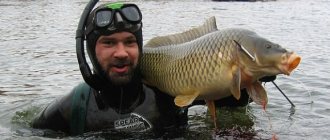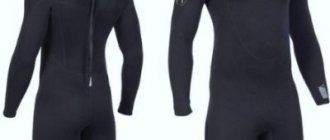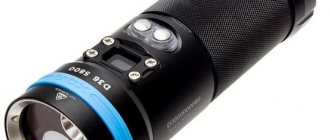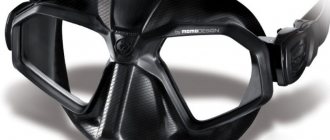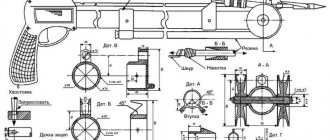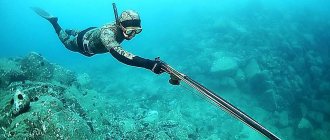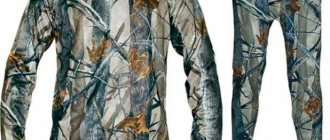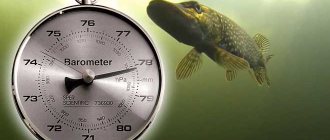| Place | Name | Characteristics in the rating |
| The best air guns |
| 1 | Salvimar Predator | Buyer's Best Choice |
| 2 | Scorpena V+, 75 cm | Optimal combination of price and quality |
| 3 | RPP-OSA-500 | The safest charging system. |
| 4 | MARES STEN-11 58 | High shooting accuracy |
| 5 | Alpinasub RPPA 380 | Best price |
| The best underwater crossbow guns |
| 1 | Salvimar METAL ROLLER, 75 | The most popular underwater gun |
| 2 | Scorpena RedLine 60 | Simple design. Possibility of the provided upgrade |
| 3 | Immersion Training 50 | The best choice for beginner spearfishers |
| 4 | OMER Cayman ET Roller | Impeccable quality. Best sighting range |
| 5 | Sargan Senezh 400 | Adjustable for any hand. Comfortable handle |
Types of underwater guns
- Crossbow. The most popular speargun design for beginners. The firing range depends on the number of rubber rods and the size of the barrel. The advantage of a crossbow is considered to be low noise, almost complete absence of recoil and high shooting reliability.
- Spring. Available with one or two springs. The simplest and most trouble-free underwater guns. Professional models are equipped with an effective design with springs of different diameters (located one inside the other), and have increased power, and therefore increased firing range.
- Pneumatic. Convenient and effective spearguns for spearfishing. Powered by compressed air, compact. However, there are also disadvantages - the equipment is noisy, often misfires, and requires care when charging. It is also difficult to aim, which affects the accuracy of the shot.
- Hydropneumatic. It does not limit the hunter at all, allowing him to easily do what he loves in any conditions, even in reservoirs with dense underwater vegetation. Hydropneumatics give the best impulse to the harpoon, and in some models the force of the shot can be adjusted. This is the most expensive spearfishing equipment.
Popular models of weapons for underwater hunting
On the modern market, guns for hunting in the aquatic environment are represented by various models of both domestic and foreign production. At the same time, it is better to give preference to proven brands, because not all companies produce high-quality and reliable products.
The most famous foreign manufacturers are: Mares (produces the highest quality diving equipment), Omer and Sporasub (Italy), Cressi Sub (France).
One of the most popular foreign-made airgun models is the Mares Jet, which is perfect not only for a professional, but also for a novice hunter.
This model is characterized by reliability, power and high shooting accuracy. It is available in two versions - with and without an installed power regulator. The barrel length is 42 cm, so the Mares Jet can be used both on the river and in the sea.
Another good option is the Belarusian pneumatic speargun “Kayuk”. The main advantage of this sample is the presence of an adjustable handle, which can be mounted either at the back or in the middle.
Among the domestic models, the Taimen gun, made in Chelyabinsk, should be highlighted. It has high accuracy and shooting efficiency in any aquatic environment. Another advantage is its simple charging mechanism, so even a novice hunter can successfully operate such a weapon.
When choosing an underwater gun, first of all, decide on the conditions of its operation. There is no need to buy a universal kit and overpay a large amount of money for it. You can simply limit yourself to the minimum set suitable for a specific hunting location. At the same time, you should always have additional tips on hand so that if it breaks or gets lost, you can install a spare harpoon.
0 0 vote
Article rating
Is a permit required for a speargun?
This question arises for almost all beginners who decide to join this type of outdoor activity.
At the moment, the legislation of the Russian Federation does not provide for any permits for underwater guns of all types. At the same time, there are often cases when fishery inspectors, police officers or employees of other law enforcement agencies make a detention, confiscate this equipment or draw up an administrative protocol. In fact, there are only a few requirements that the owner should consider:
- The speargun should be stored and transported in a special case and unloaded.
- The use of underwater guns in crowded places (beaches, swimming pools, etc.) is prohibited.
- Use together with breathing apparatus (scuba gear). In almost all countries it is equated to poaching (the exception is the USA).
- A ban on fishing during the spawning period, as well as compliance with other fishing rules in force in the Russian Federation.
All other interpretations can be safely appealed in court, not forgetting about moral damage.
Spearfishing for beginners.
—> Everything written below is a private opinion and personal experience, in no way claiming to be true for everyone!
The main thing you need to decide on is that there are two types of spearfishing: sea and freshwater.
We won’t touch the sea one for now
a) freshwater can be divided into three independent subspecies:
- “duremarstvo” - reed and coastal with dives to a depth of 5 - 7 meters
— “serious” — dives to a depth of 10+ meters, into rubble, under the shore, in the current, in winter
- “night” - actually all of the above is only at night (it has its own characteristics)
b) there is also winter hunting with diving under the ice, it can be burdened with all the above-mentioned delights of “serious” hunting and I don’t want to talk about it at all, because I categorically do not understand those desperate daredevils who are engaged in this suicidal business
Let's assume that you are at the beginning of the Podvokhov path.
What you need to get started:
1. Suit for freediving and spearfishing) with open (bare) pores, neoprene 5 mm. It is the most versatile.
Note: you don’t need to take anything very expensive right away, the optimal choice is a legendary classic, like the Busch Mundial Equip, if the tricky theme goes with you, then there will be at least three or four suits (3mm - summer, 5mm - summer-demi-season, 7mm - demi-season). winter, 9-10mm - winter) and there will still be time to figure out what kind of suits you like, no neoprenes from Yamomoto and so on. you don't need them at the beginning. You must try on your suit! They either try it on right in the store (decent stores have a shower) or they give the suit home and take it back without talking if it doesn’t fit.
At a depth of 5 meters (this is very different at different times in different bodies of water), a thermocline will await you - a sharp transition into a layer of cold water.
If you dive below the thermocline and have good apnea and you sit there in ambush for a minute, then you will need 7mm neoprene even in the heat.
2. 3 mm gloves.
Note: for warm water and shallow diving, simple car gloves are sufficient; in the fall, 3mm ones will come in handy.
3. Socks 3-5 mm.
4. Sea fins from 80 cm blade, medium hardness.
Note: no carbon is needed (it is for deep dives from 10 meters), fins are measured on socks, so they are often bought at the same time.
5. Low-volume freediving mask, black silicone.
Note: no liquids or gels are needed to “anti-fog” the mask - it’s diluted, the best remedy is your own saliva, if you are a bespectacled person, take a mask where you can order glasses with diopters.
6. Plain black tube, soft silicone, no valves, etc.
7. A knife with a serrated sharpening, medium size, with a sheath for quick removal and insertion and with shoulder and leg straps.
Note: no pirate scimitars! You don’t need a sharp tip (you’ll end up piercing yourself), the knife should be located where you can reach with your hand with your elbow pressed to your body (press, fumble and you’ll immediately understand).
8. The weight belt is wide, rubber, with a Marseilles buckle (no other is needed!).
Note: you don’t need to take any weights on your arms and legs now, first just a belt, then based on your impression of the process you will decide what exactly is needed.
9. Classic belt weights: 2 kg. — 2 pcs., 1 kg. - 4 things.
Note: more precisely, the weights must be selected according to their own weight and the thickness of the suit, the final check is on a pond, so it is better to take one extra and remove it from the belt, it is better to take weights in plastic (“drenched”), they stain your hands less.
10. Cargo bag.
Note: this is really important, heavy loads must be stored separately from neoprene and other equipment so as not to damage the latter.
11. Kukan Vinogradova (rope in transparent plastic).
Note: you need to be able to cut it if anything happens, so no cables!
12. Handheld flashlight (600 - 800 lumens).
13. Pneumatic gun with a barrel from 50 to 60 cm (preferably with a 2/3 handle).
14. A reel on a gun with a wound line of about 25 meters minimum.
15. Harpoons (at least 2 pieces) made of hardened steel, Tahitian (one or two flags), with a line (preferably a monofilament line) about 3-4 meters.
16. Magnetic line reset.
17. Metal “T”-shaped charger.
18. Repair kit: - monoline - about 15 m. - clamps for monoline - crimping pliers or pliers - lighter - water-resistant electrical tape (black) - carabiner pin - 2 pcs.
19. Large PVC bag (1 meter long) for a suit, fins, etc.
20. Gun bag.
21. Dive computer with a minimum set of functions: - date - time - water temperature - apnea time - dive depth
Note: at the beginning it is definitely not needed, it is for those who often dive from 5 meters and deeper and for sea hunting, it is an expensive thing, you need to order from abroad, you need to dive, understand that you are carried away and then...
22. Freediver's buoy (required by the legislation of some countries): - flag - fasteners for harpoon guns, nets with fish and fresh water - line of at least 25 meters - belt quick-release weight with a clip - line winding
Note: it is definitely not needed yet, in Russia it is not applicable in practice, since it is not convenient and even dangerous (hooks), its presence is required at competitions and nowhere else.
23. It is recommended to have additional things with you: - a container for a key or phone: the car is on the shore, closed, the car key is in the container and on the elbow, you can put a small old Nokia in the container (communication is important); — liquid soap: always useful when traveling, wash your snorkel mask, wash your hands, drop it into your suit to make dressing easier; — large garbage bags (120-160 liters): cover the car seat so that you can sit in a wet suit, pack fish, etc.; — earplugs and simple pharmacy petroleum jelly: fresh water from a reservoir, constantly penetrating into the ear, can cause inflammation and it is better to prevent this; — ear anti-inflammatory drying drops: apply urgently if you still feel that something is happening in the ear; — nasal drops with a mild vasoconstrictor effect: from long swimming with breathing through a snorkel and diving, swelling of the nasal mucosa may begin.
All of the above, except for the indicated pneumatic guns and harpoons for them, are completely suitable for sea hunting.
Adviсe:
1) spearfishing is a hobby for singles
you can come to the pond with a company, but underwater your route must be done alone, it’s safe, and there’s no other way, where one trick happened, the second has nothing to do in the near future, the fish is either caught or scared away, and the dregs are with fins raised, two people don't hunt together
2) the gun has the right to be loaded only in water
a loaded gun should sink, an unloaded gun should float
This is achieved by the correct choice of gun and selection of compensator floats
3) no alcohol, neither before nor during
4) everything is done calmly and slowly
any sudden movements scare the fish and waste a lot of oxygen
sudden movement is a common cause of getting caught
5) we behave very carefully on and under water
we look, we think, we look again, we think again and only then do we climb
We constantly look around, at the slightest feeling of abnormality or strangeness of what is happening, we stop and calmly begin to emerge
Let's not dive into the invisible!
6) we feel very sorry for ourselves
listen to ourselves and never overcome anything
the heart is beating - to the shore! headache - go to shore! It just doesn’t seem to roll - onto the shore!
We don’t set any records, everything is just for fun and with minimal stress
the first desire to inhale - we begin the ascent
7) we do not spare equipment and fish - these are all things that come and go
If there is any doubt or difficulty, we drop everything! belts with weights, cucans with trophies, guns, cameras
If you have to choose - throw it or cut it out of the network - throw it!
8. no panic
the elephant's calmness in any critical situation
panic excitation of brain zones can consume all the remaining oxygen in seconds
nerves are your enemy
even after the last second of your ultimate apnea, there are always a few more seconds during which you will be able to act
got into a situation - calmly get out, any other behavior is death
Topic for discussion on the forum: https://www.mooir.ru/forum/index.php?/topic/9671-%D…
—> leave a comment
